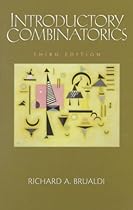Introductory Combinatorics (3rd Edition)

| Author | : | |
| Rating | : | 4.58 (517 Votes) |
| Asin | : | 0131814885 |
| Format Type | : | paperback |
| Number of Pages | : | 614 Pages |
| Publish Date | : | 2017-12-16 |
| Language | : | English |
DESCRIPTION:
. Level is dead center. From the Publisher The market best seller
nice accessable text Most (but not all) of the copious errors in earlier editions have been fixed.(Brualdi maintains an errata list on his website.) I like this book a lot,it has a nice, relaxed style of exposition and the choice of topics is goodfor an introductory course.. Interesting Problems, Too Many Mistakes A Customer I used the book to guide me through a Combinatorics class I took in the summer of 1998. The author has presented some very interesting problems like prove that of any 10 points chosen withen an equlateral triangle of side length 1, there are 2 whose distance apart is at most 1/3 that use some interesting techniques such as the pigeonhole principal. The book, however contained too many mistakes. My professor said on average there is one mistake per page and he wasn't exagerating either. Luckily with his help, we corrected the many mistakes and then were successfully able to use the book. I notice that the author has written a new edi. Meromorphchick said Unusable. I'm very surprised that this book is in its 5th edition and it still has a many errors. There are even errors in statements of theorems, which is really scary, and many errors in the back of the book where you are supposed to be able to check your answers.I have very little faith in this textbook. If it weren't in use for my course (and I'm not sure why it is, because I have yet to find its good qualities) I would never have bought it.Hopefully the publishers hire a math grad student or two for editing the sixth edition.
The third edition of Introductory Combinatorics has been updated to include new material on partially ordered sets, Dilworth's Theorem, partitions of integers and generating functions. It also includes problems that offer good practice of the principles it presents. It presents an excellent treatment of Polya's Counting Theorem that doesn't assume the student is familiar with group theory. In addition, the chapters on graph theory have been completely revised. Written to be entertaining and readable, this book's lively style reflects the author's joy for teaching the subject. A v
